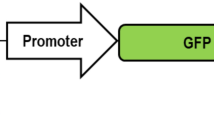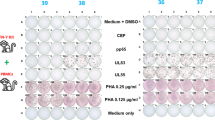Abstract
Legitimate uses of gene transfer technology can benefit from sensitive detection methods to determine vector biodistribution in pre-clinical studies and in human clinical trials, and similar methods can detect illegitimate gene transfer to provide sports-governing bodies with the ability to maintain fairness. Real-time PCR assays were developed to detect a performance-enhancing transgene (erythropoietin, EPO) and backbone sequences in the presence of endogenous cellular sequences. In addition to developing real-time PCR assays, the steps involved in DNA extraction, storage and transport were investigated. By real-time PCR, the vector transgene is distinguishable from the genomic DNA sequence because of the absence of introns, and the vector backbone can be identified by heterologous gene expression control elements. After performance of the assays was optimized, cynomolgus macaques received a single dose by intramuscular (IM) injection of plasmid DNA, a recombinant adeno-associated viral vector serotype 1 (rAAV1) or a rAAV8 vector expressing cynomolgus macaque EPO. Macaques received a high plasmid dose intended to achieve a significant, but not life-threatening, increase in hematocrit. rAAV vectors were used at low doses to achieve a small increase in hematocrit and to determine the limit of sensitivity for detecting rAAV sequences by single-step PCR. DNA extracted from white blood cells (WBCs) was tested to determine whether WBCs can be collaterally transfected by plasmid or transduced by rAAV vectors in this context, and can be used as a surrogate marker for gene doping. We demonstrate that IM injection of a conventional plasmid and rAAV vectors results in the presence of DNA that can be detected at high levels in blood before rapid elimination, and that rAAV genomes can persist for several months in WBCs.
This is a preview of subscription content, access via your institution
Access options
Subscribe to this journal
Receive 12 print issues and online access
$259.00 per year
only $21.58 per issue
Buy this article
- Purchase on Springer Link
- Instant access to full article PDF
Prices may be subject to local taxes which are calculated during checkout




Similar content being viewed by others
References
Baoutina A, Alexander IE, Rasko JE, Emslie KR . Potential use of gene transfer in athletic performance enhancement. Mol Ther 2007; 15: 1751–1766.
Wells DJ . Gene doping: the hype and the reality. Br J Pharmacol 2008; 154: 623–631.
Verdier F, Descotes J . Preclinical safety evaluation of human gene therapy products. Toxicol Sci 1999; 47: 9–15.
Gonin P, Gaillard C . Gene transfer vector biodistribution: pivotal safety studies in clinical gene therapy development. Gene Therapy 2004; 11 (Suppl 1): S98–S108.
Provost N, Le Meur G, Weber M, Mendes-Madeira A, Podevin G, Cherel Y et al. Biodistribution of rAAV vectors following intraocular administration: evidence for the presence and persistence of vector DNA in the optic nerve and in the brain. Mol Ther 2005; 11: 275–283.
Lai L, Davison BB, Veazey RS, Fisher KJ, Baskin GB . A preliminary evaluation of recombinant adeno-associated virus biodistribution in rhesus monkeys after intrahepatic inoculation in utero. Hum Gene Ther 2002; 13: 2027–2039.
Favre D, Provost N, Blouin V, Blancho G, Cherel Y, Salvetti A et al. Immediate and long-term safety of recombinant adeno-associated virus injection into the nonhuman primate muscle. Mol Ther 2001; 4: 559–566.
Toromanoff A, Cherel Y, Guilbaud M, Penaud-Budloo M, Snyder RO, Haskins ME et al. Safety and efficacy of regional intravenous (r.i.) versus intramuscular (i.m.) delivery of rAAV1 and rAAV8 to nonhuman primate skeletal muscle. Mol Ther 2008; 16: 1291–1299.
Schenk-Braat EA, van Mierlo MM, Wagemaker G, Bangma CH, Kaptein LC . An inventory of shedding data from clinical gene therapy trials. J Gene Med 2007; 9: 910–921.
Fisher KJ, Jooss K, Alston J, Yang Y, Haecker SE, High K et al. Recombinant adeno-associated virus for muscle directed gene therapy. Nat Med 1997; 3: 306–312.
Xiao X, Li J, Samulski RJ . Efficient long-term gene transfer into muscle tissue of immunocompetent mice by adeno-associated virus vector. J Virol 1996; 70: 8098–8108.
Snyder RO, Spratt SK, Lagarde C, Bohl D, Kaspar B, Sloan B et al. Efficient and stable adeno-associated virus-mediated transduction in the skeletal muscle of adult immunocompetent mice. Hum Gene Ther 1997; 8: 1891–1900.
Wu Z, Asokan A, Samulski RJ . Adeno-associated virus serotypes: vector toolkit for human gene therapy. Mol Ther 2006; 14: 316–327.
Flotte TR, Conlon TJ, Poirier A, Campbell-Thompson M, Byrne BJ . Preclinical characterization of a recombinant adeno-associated virus type 1-pseudotyped vector demonstrates dose-dependent injection site inflammation and dissemination of vector genomes to distant sites. Hum Gene Ther 2007; 18: 245–256.
Wolff JA, Williams P, Acsadi G, Jiao S, Jani A, Chong W . Conditions affecting direct gene transfer into rodent muscle in vivo. Biotechniques 1991; 11: 474–485.
Jiao S, Williams P, Berg RK, Hodgeman BA, Liu L, Repetto G et al. Direct gene transfer into nonhuman primate myofibers in vivo. Hum Gene Ther 1992; 3: 21–33.
Vigen KK, Hegge JO, Zhang G, Mukherjee R, Braun S, Grist TM et al. Magnetic resonance imaging-monitored plasmid DNA delivery in primate limb muscle. Hum Gene Ther 2007; 18: 257–268.
Manno CS, Chew AJ, Hutchison S, Larson PJ, Herzog RW, Arruda VR et al. AAV-mediated factor IX gene transfer to skeletal muscle in patients with severe hemophilia B. Blood 2003; 101: 2963–2972.
Manno CS, Pierce GF, Arruda VR, Glader B, Ragni M, Rasko JJ et al. Successful transduction of liver in hemophilia by AAV-Factor IX and limitations imposed by the host immune response. Nat Med 2006; 12: 342–347.
Hengge UR, Dexling B, Mirmohammadsadegh A . Safety and pharmacokinetics of naked plasmid DNA in the skin: studies on dissemination and ectopic expression. J Invest Dermatol 2001; 116: 979–982.
Hagstrom JE, Hegge J, Zhang G, Noble M, Budker V, Lewis DL et al. A facile nonviral method for delivering genes and siRNAs to skeletal muscle of mammalian limbs. Mol Ther 2004; 10: 386–398.
Su LT, Gopal K, Wang Z, Yin X, Nelson A, Kozyak BW et al. Uniform scale-independent gene transfer to striated muscle after transvenular extravasation of vector. Circulation 2005; 112: 1780–1788.
Rivera VM, Gao GP, Grant RL, Schnell MA, Zoltick PW, Rozamus LW et al. Long-term pharmacologically regulated expression of erythropoietin in primates following AAV-mediated gene transfer. Blood 2005; 105: 1424–1430.
Van Vliet KM, Blouin V, Brument N, Agbandje-McKenna M, Snyder RO . The role of the adeno-associated virus capsid in gene transfer. Methods Mol Biol 2008; 437: 51–91.
Gao GP, Alvira MR, Wang L, Calcedo R, Johnston J, Wilson JM . Novel adeno-associated viruses from rhesus monkeys as vectors for human gene therapy. Proc Natl Acad Sci USA 2002; 99: 11854–11859.
Stroes ES, Nierman MC, Meulenberg JJ, Franssen R, Twisk J, Henny CP et al. Intramuscular administration of AAV1-lipoprotein lipase S447X lowers triglycerides in lipoprotein lipase-deficient patients. Arterioscler Thromb Vasc Biol 2008; 28: 2303–2304.
Duan D, Sharma P, Yang J, Yue Y, Dudus L, Zhang Y et al. Circular intermediates of recombinant adeno-associated virus have defined structural characteristics responsible for long-term episomal persistence in muscle tissue. J Virol 1998; 72: 8568–8577.
Schnepp BC, Clark KR, Klemanski DL, Pacak CA, Johnson PR . Genetic fate of recombinant adeno-associated virus vector genomes in muscle. J Virol 2003; 77: 3495–3504.
Vincent-Lacaze N, Snyder RO, Gluzman R, Bohl D, Lagarde C, Danos O . Structure of adeno-associated virus vector DNA following transduction of the skeletal muscle. J Virol 1999; 73: 1949–1955.
Penaud-Budloo M, Le Guiner C, Nowrouzi A, Toromanoff A, Cherel Y, Chenuaud P et al. Adeno-associated virus vector genomes persist as episomal chromatin in primate muscle. J Virol 2008; 82: 7875–7885.
Espy MJ, Uhl JR, Sloan LM, Buckwalter SP, Jones MF, Vetter EA et al. Real-time PCR in clinical microbiology: applications for routine laboratory testing. Clin Microbiol Rev 2006; 19: 165–256.
Lock M, McGorray S, Auricchio A, Ayuso E, Beecham EJ, Blouin V et al. Characterization of a recombinant adeno-associated virus type 2 reference standard material. Hum Gene Ther 2010; 21: 1273–1285.
Gao G, Lebherz C, Weiner DJ, Grant R, Calcedo R, McCullough B et al. Erythropoietin gene therapy leads to autoimmune anemia in macaques. Blood 2004; 103: 3300–3302.
Chenuaud P, Larcher T, Rabinowitz JE, Provost N, Cherel Y, Casadevall N et al. Autoimmune anemia in macaques following erythropoietin gene therapy. Blood 2004; 103: 3303–3304.
Baoutina A, Coldham T, Bains GS, Emslie KR . Gene doping detection: evaluation of approach for direct detection of gene transfer using erythropoietin as a model system. Gene Therapy 2010; 17: 1022–1032.
Beiter T, Zimmermann M, Fragasso A, Hudemann J, Niess AM, Bitzer M et al. Direct and long-term detection of gene doping in conventional blood samples. Gene Therapy 2010 (in press).
Lu Y, Song S . Distinct immune responses to transgene products from rAAV1 and rAAV8 vectors. Proc Natl Acad Sci USA 2009; 106: 17158–17162.
Brantly ML, Chulay JD, Wang L, Mueller C, Humphries M, Spencer LT et al. Sustained transgene expression despite T lymphocyte responses in a clinical trial of rAAV1-AAT gene therapy. Proc Natl Acad Sci USA 2009; 106: 16363–16368.
Liu F, Shollenberger LM, Conwell CC, Yuan X, Huang L . Mechanism of naked DNA clearance after intravenous injection. J Gene Med 2007; 9: 613–619.
Hughes TS, Langer SJ, Johnson KW, Chavez RA, Watkins LR, Milligan ED et al. Intrathecal injection of naked plasmid DNA provides long-term expression of secreted proteins. Mol Ther 2009; 17: 88–94.
Mayrhofer P, Blaesen M, Schleef M, Jechlinger W . Minicircle-DNA production by site specific recombination and protein-DNA interaction chromatography. J Gene Med 2008; 10: 1253–1269.
Gill DR, Pringle IA, Hyde SC . Progress and prospects: the design and production of plasmid vectors. Gene Therapy 2009; 16: 165–171.
Chenuaud P, Larcher T, Rabinowitz JE, Provost N, Joussemet B, Bujard H et al. Optimal design of a single recombinant adeno-associated virus derived from serotypes 1 and 2 to achieve more tightly regulated transgene expression from nonhuman primate muscle. Mol Ther 2004; 9: 410–418.
Acknowledgements
We thank Michael L Nickerson, PhD (NCI Frederick), Mahajoub Bello-Roufai, PhD (UF CERHB), Oumeya Adjali, MD, PhD, James Baus for helpful discussions, Yan Chérel, DVM, PhD, Béatrice Joussemet, DVM, PhD, and Delphine Nivard for technical assistance, the personnel at the Boisbonne Centre (large animal facility, ONIRIS, Nantes) and the Vector Core at the University Hospital of Nantes for providing the rAAV1 and rAAV8 stocks. This project was funded by the World Anti-Doping Agency (ROS and PM), United States Anti-Doping Agency (ROS) and the Agence Francaise de Lutte contre le Dopage (PM). This work was performed under a Cooperative Agreement between INSERM, AFM, l’Etablissement Francais du Sang (EFS) and the University of Florida Center of Excellence for Regenerative Health Biotechnology.
Author information
Authors and Affiliations
Corresponding author
Ethics declarations
Competing interests
ROS is an inventor on patents related to recombinant AAV technology. ROS owns equity in a gene therapy company that is commercializing AAV for gene therapy applications. To the extent that the work in this manuscript increases the value of these commercial holdings, ROS has a conflict of interest.
Rights and permissions
About this article
Cite this article
Ni, W., Le Guiner, C., Gernoux, G. et al. Longevity of rAAV vector and plasmid DNA in blood after intramuscular injection in nonhuman primates: implications for gene doping. Gene Ther 18, 709–718 (2011). https://doi.org/10.1038/gt.2011.19
Received:
Revised:
Accepted:
Published:
Issue Date:
DOI: https://doi.org/10.1038/gt.2011.19
Keywords
This article is cited by
-
Prospective approaches to gene therapy computational modeling – spotlight on viral gene therapy
Journal of Pharmacokinetics and Pharmacodynamics (2023)
-
Screening for gene doping transgenes in horses via the use of massively parallel sequencing
Gene Therapy (2022)
-
Control of gene doping in human and horse sports
Gene Therapy (2022)
-
Gendoping und molekulares Doping
Rechtsmedizin (2021)
-
Synthetic certified DNA reference material for analysis of human erythropoietin transgene and transcript in gene doping and gene therapy
Gene Therapy (2016)



